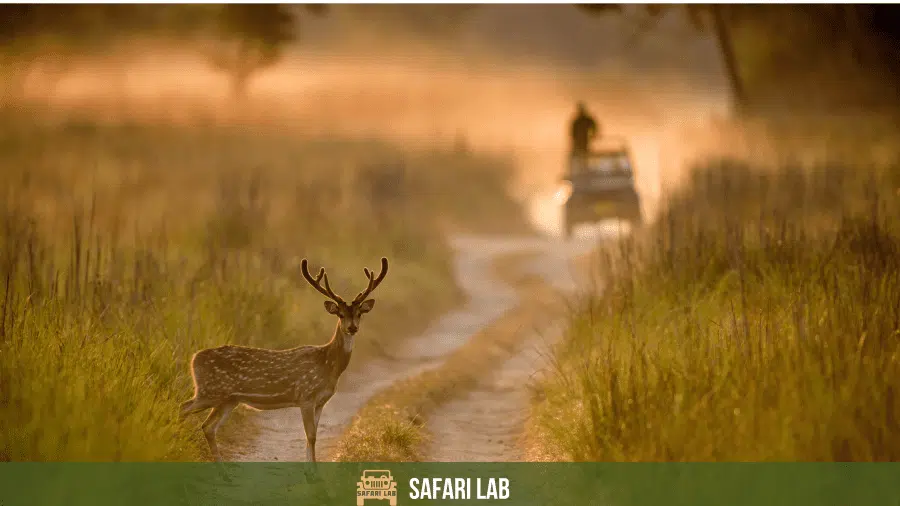Are you ready for an adventure that will bring you face to face with one of nature’s most majestic creatures? Then buckle up, because we’re diving deep into the world of the Royal Bengal Tiger.
This magnificent predator has fascinated humans for centuries, and today, we are going to explore why.
We’ll delve into its habitat, physical characteristics, and behavior, as well as the vital role it plays in Indian culture. So without further ado, let’s get started!
Meet the Royal Bengal Tiger: India’s Fierce and Majestic Predator
The Royal Bengal Tiger, or Panthera tigris tigris, is a tiger subspecies found primarily in India, with smaller populations in Bangladesh, Nepal, and Bhutan. It is the most numerous of all tiger subspecies, but despite this, it remains a threatened species.
The International Union for Conservation of Nature (IUCN) lists the Royal Bengal Tiger as endangered, primarily due to poaching and habitat loss.
It is estimated that there are just around 2,500 adult Bengal tigers left in the wild. This number has significantly decreased from the early 20th century when their population was estimated to be around 100,000.
Poaching is one of the major threats to the survival of the Royal Bengal Tiger.
Their body parts, such as bones, skin, and whiskers, are highly valued in traditional medicine and fetch high prices on the black market. Additionally, their beautiful fur is sought after for fashion purposes.
Habitat loss is another significant factor contributing to the endangerment of Bengal tigers. Deforestation, primarily for agriculture, logging, and human settlements, has resulted in the fragmentation and degradation of their natural habitats.
This loss of habitat restricts their range and reduces their prey base, making it harder for them to survive.
Conservation efforts are being made to protect the Royal Bengal Tiger.
Numerous protected areas and national parks have been established in Bangladesh, Nepal, and Bhutan to provide a safe haven for these majestic creatures.
Anti-poaching measures have also been implemented to combat illegal hunting, and initiatives are underway to restore and protect their habitats.
It is crucial for governments, conservation organizations, and local communities to work together to ensure the long-term survival of the Royal Bengal Tiger.
Strict law enforcement, community engagement, and sustainable development practices are essential to address the root causes of poaching and habitat loss. Only through these collective efforts can we hope to secure a future for this iconic species.
Why the Royal Bengal Tiger Captures Our Imagination
There’s something about the Royal Bengal Tiger that captivates us.
Perhaps it’s their striking beauty, with their rich, orange coats marked by black stripes. Or maybe it’s their raw power and majesty, signifying strength and courage.
From the first time we saw a Tiger in the Wild in the magnificent Corbett Tiger Reserve, we have been hooked to this incredible species.
Tigers are the largest members of the cat family and are known for their awe-inspiring presence. Their size alone is enough to capture anyone’s attention, with adult males weighing up to 600 pounds and measuring over 9 feet in length.
They possess a muscular build, designed for speed and agility, making them one of the most efficient predators in the animal kingdom.
But it’s not just their physical attributes that make tigers so captivating. It’s their behavior and characteristics that truly fascinate us.
Tigers are solitary creatures, preferring to roam and hunt alone. This independent nature adds an air of mystery to their persona, as they navigate their territories with grace and stealth.
Their hunting prowess is legendary. Tigers are incredibly skilled hunters, capable of taking down prey much larger than themselves.
They are ambush predators, using their camouflage and patience to stalk their prey before launching a lightning-fast attack. Witnessing this display of power and strategy in the wild is an experience like no other.
Yet, despite their formidable reputation, tigers are also remarkably beautiful. Their vibrant orange coats, adorned with striking black stripes, create a mesmerizing pattern that is instantly recognizable. This unique coloration serves as both camouflage and identification, allowing tigers to blend seamlessly into their surroundings while also showcasing their individuality.
Understanding the Royal Bengal Tiger’s Habitat
Royal Bengal Tigers inhabit a variety of environments, from the grasslands and marshes of the Sundarbans to the forested foothills of the Himalayas.
They are highly adaptable creatures, capable of surviving in both hot, dry regions and cold, mountainous terrains.
However, they are primarily found in the Indian subcontinent, including Bangladesh, Bhutan, India, and Nepal.
In the Sundarbans, a mangrove forest located in Bangladesh and India, the Royal Bengal Tigers have adapted to living in a unique ecosystem.
These tigers are excellent swimmers and often swim across rivers and channels that crisscross the Sundarbans. They are known for their ability to hunt in water, preying on fish, crustaceans, and other aquatic animals.
In the grasslands and marshes of the Sundarbans, tigers rely on their camouflage to blend into the tall grass and sneak up on their prey.
They primarily feed on deer, wild boar, and various types of monkeys found in the region.
In the forested foothills of the Himalayas, Royal Bengal Tigers inhabit dense forests with diverse vegetation. Here, their diet consists of larger prey like sambar deer, barking deer, and wild pigs.
The rugged terrain provides ample cover for these tigers to ambush their prey.
These tigers have adapted to live in a wide range of temperatures, from the scorching heat of the Indian plains to the freezing cold of the Himalayan mountains.
Their thick fur coat helps them survive in colder climates, while their large size and muscular build enable them to tackle larger prey in warmer regions.
Despite their adaptability, Royal Bengal Tigers face numerous threats to their survival.
Habitat loss due to deforestation, poaching for their body parts, and human-wildlife conflict are some of the major challenges faced by these magnificent creatures. Conservation efforts are crucial to ensuring the long-term survival of the Royal Bengal Tiger population.
Physical Characteristics: What makes the Tiger unique
The Royal Bengal Tiger is an apex predator with distinctive physical characteristics. Adult males can reach up to 10 feet in length and weigh between 180-260 kg.
Females, or tigresses, are slightly smaller but no less formidable.
Their vibrant orange coats, patterned with unique black stripes, act as excellent camouflage in their various habitats such as dense forests, grasslands, and mangrove swamps.
These stripes help them blend into the surrounding vegetation, making it easier for them to sneak up on their prey.
The Royal Bengal Tiger has muscular bodies and strong limbs, enabling them to chase down and capture their prey with great speed and agility.
They have sharp retractable claws that can be extended when needed for hunting or self-defense. Their powerful jaws are equipped with long and sharp canine teeth, which they use to deliver a deadly bite to their prey’s neck or throat.
One of the most distinctive features of the Royal Bengal Tiger is its size. It is one of the largest tiger subspecies and holds the title for being the biggest wild cat in the world.
Its large size and strength make it an apex predator, meaning it doesn’t have any natural predators in its habitat.
Behavior and Lifestyle of the Royal Bengal Tiger
As solitary and territorial creatures, Royal Bengal Tigers mark their territories with scent markings and vocalizations.
They are primarily nocturnal hunters, relying on their acute senses of sight and hearing to stalk and ambush their prey in the darkness.
With their powerful jaws and sharp teeth, Royal Bengal Tigers are able to bring down large prey such as deer, wild boars, and even cattle.
These majestic creatures are known for their distinctive orange coat with black stripes, which provide excellent camouflage in their natural habitat of dense jungles and grasslands.
They have muscular bodies and strong limbs, allowing them to move swiftly and silently through the undergrowth while hunting.
During the day, Royal Bengal Tigers typically rest in shady areas or near water sources to beat the heat. They are excellent swimmers and are not afraid to enter rivers or lakes to catch their prey.
In fact, they are one of the few big cat species that enjoy water and are capable of swimming long distances.
The Royal Bengal Tiger in Indian Culture
The Tiger in Indian Mythology and Folklore
In the rich tapestry of Indian mythology and folklore, the tiger holds a prominent place. It is often associated with power, courage, and grace. The Goddess Durga, a fierce warrior deity in Hindu mythology, is often depicted riding a tiger, symbolizing her mastery over power and force.
The Tiger as a National Symbol in India
Living with the Royal Bengal Tiger
Human-Tiger Coexistence: Challenges and Success Stories
Coexistence between humans and tigers is fraught with challenges, primarily due to habitat encroachment and retaliatory killings. However, initiatives like Project Tiger have shown promising results in mitigating human-tiger conflicts and fostering coexistence.between the two species.
By preserving and restoring tiger habitats, implementing community-based conservation efforts, and raising awareness about the importance of tiger conservation, Project Tiger has helped reduce instances of human-tiger conflicts.
Through these initiatives, local communities have been empowered to actively participate in tiger conservation and find alternative livelihood options, reducing their dependence on tiger habitats for resources.
This has not only improved the survival prospects of tigers but also created a more harmonious relationship between humans and tigers, allowing both to coexist in a sustainable manner.
The Impact of the Royal Bengal Tiger on Local Communities
The presence of the Royal Bengal Tiger can be both a blessing and a curse for local communities. While they attract tourism and contribute to local economies, they also pose threats to livestock and, in rare cases, human lives.
Inspiring Tales of Tiger Conservationists
India is home to many passionate tiger conservationists whose dedicated efforts are instrumental in protecting this majestic species. From forest rangers risking their lives to keep poachers at bay, to scientists studying tiger behavior and habitats, these brave individuals serve as an inspiration to us all.
The Royal Bengal Tiger is not just a national animal but a symbol of India’s wild beauty. Its image graces everything from currency to postage stamps, serving as a constant reminder of India’s commitment to wildlife conservation.
Conservation Efforts and the Role of the Tiger in India’s Wildlife Tourism
India’s commitment to tiger conservation is evident in its numerous national parks and reserves, key attractions for wildlife tourism. The Royal Bengal Tiger plays a significant role in attracting tourists, contributing to local economies and promoting awareness about conservation efforts.
7 Facts About the Bengal Tiger
Tiger’s Average Lifespan in the wild
In the wild, Royal Bengal Tigers have an average lifespan of 10-15 years. They live longer in captivity, often reaching up to 20 years of age. There are various factors that determine how long a wild tiger survives. These include availability of prey, competition for resources, disease and injuries, human activities such as poaching or habitat destruction, and natural disasters.
Tigers that have access to abundant prey and a large territory tend to have a better chance of survival. However, factors such as conflicts with humans or other tigers can result in injuries or death.
Additionally, diseases like canine distemper or injuries caused by fights with prey can also impact their lifespan. Conservation efforts and protected areas can help increase the chances of tiger survival in the wild.
Tiger’s Sleeping Habits
Did you know that tigers are quite the snoozers? They can sleep for up to 18 hours a day, usually during the hot daytime hours, becoming active as the day cools down.
Their sleeping habits are influenced by their natural habitat and hunting patterns. Tigers often rest during the day to conserve energy, as they are primarily nocturnal hunters.
Additionally, sleeping during the hot daytime hours helps them avoid the heat and conserve water in their bodies.
They become more active during the cooler hours, such as early morning or evening, when their chances of successful hunting are higher.
Tiger – The Solitary Big Cat
Tigers are solitary creatures, preferring to live and hunt alone. They fiercely defend their territories from other tigers, using scent markings and vocalizations to warn off intruders.and potential threats.
Tigers are highly territorial animals, and the size of their territories varies depending on factors such as prey availability and habitat quality.
Scent marking plays a crucial role in tigers’ territorial defense. They use their urine to mark trees, rocks, or other prominent objects within their territory.
By doing so, they communicate their presence and claim ownership over the area. These scent markings also serve as a warning to other tigers, indicating that the territory is already occupied.
In addition to scent marking, tigers also utilize vocalizations to establish their dominance and warn off intruders. They can produce a variety of sounds, including roars, growls, hisses, and moans. Roaring, in particular, is one of the most iconic vocalizations of tigers.
It serves as a long-range communication method, allowing them to announce their presence and assert their territorial boundaries.
When confronted with an intruder, tigers may engage in aggressive behaviors to defend their territory. They display threatening body postures, such as arching their back, baring their teeth, and growling.
Physical confrontations between tigers are rare, as these displays are usually sufficient to intimidate and deter potential rivals.
The solitary nature of tigers is primarily driven by their hunting habits. They are apex predators and require large amounts of prey to sustain themselves.
Living alone allows them to have exclusive access to their hunting grounds without having to share food resources with other tigers. Solitary living also reduces competition and the risk of injuries during hunting.
However, there are exceptions to this solitary behavior. Tigers may temporarily associate with each other during mating season or when raising cubs. Female tigers are more tolerant of sharing their territory with their offspring, while males generally maintain larger territories that encompass multiple female territories.
Overall, tigers’ solitary nature, fierce territorial defense, and communication methods through scent markings and vocalizations all contribute to their ability to survive and thrive in their respective habitats.
Tiger’s Vision & Hearing Sense
The Royal Bengal Tiger’s vision is six times better than a human’s at night, making them formidable nocturnal hunters.
With their exceptional vision, the Royal Bengal Tigers can see clearly in low light conditions, giving them a significant advantage during nighttime hunts.
Their eyes are specially adapted with a higher number of rod cells, which are responsible for detecting light and motion. This enables them to spot even the slightest movement in the darkness, making it easier for them to ambush their prey.
In addition to their sharp vision, these tigers possess excellent hearing capabilities. Their ears are designed to capture a wide range of frequencies, allowing them to pick up sounds from far distances. This acute hearing helps them detect the movements and calls of their prey, ensuring a successful hunt.
The Royal Bengal Tiger’s sense of smell is crucial for locating prey as well as marking their territory. They have a highly developed olfactory system, with a larger nasal cavity and more scent receptors than humans. This enables them to detect the presence of other animals, identify potential mates, and mark their territory boundaries with urine and scent markings.
Overall, the combination of superior night vision, acute hearing, and a keen sense of smell makes the Royal Bengal Tiger a formidable nocturnal hunter.
These sensory adaptations allow them to survive and thrive in their natural habitat, ensuring their place as one of the most majestic and powerful predators on Earth.
Mating and Parenthood
Royal Bengal Tigers mate throughout the year, but most cubs are born between November and April. A tigress will give birth to 2-3 cubs, which she raises alone.
The cubs stay with their mother for about two years before setting off on their own.to establish their own territories.
During this time, the mother teaches her cubs essential hunting and survival skills. The male tigers do not play a role in raising the cubs and may even pose a threat to them if they come into contact.
Although there have been exceptions with male tigers displaying fatherly behavior and playing doting fathers to their cubs.
After reaching maturity, around 2-3 years of age, the young tigers leave their mother’s territory to find their own home range.
This usually involves traveling long distances to avoid competition with other tigers, especially males. They mark their territories by spraying urine and leaving scratch marks on trees, indicating their presence and warning other tigers to stay away.
Male tigers typically establish larger territories that overlap with several female territories, allowing them to mate with multiple females.
They will defend their territory from other males through vocalizations, scent marking, and occasional fights if necessary.
Female tigers, on the other hand, have smaller territories and are more likely to have overlapping ranges with other females. This can lead to conflicts over resources, such as prey or water sources.
When a female is ready to mate, she will advertise her availability through scent marking and vocalizations.
Male tigers will then track her down, often traveling long distances to find her. Once a pair mates, they will separate, and the male will continue his solitary lifestyle.
Overall, tiger mating and cub rearing is a solitary process for both males and females. Their behavior ensures that each tiger has its own territory and resources to survive and pass on their genes to the next generation.
Territory and the Battles
Tigers are territorial animals, often engaging in fierce battles to defend their home ranges. A tiger’s territory can range from 20 to 100 square kilometers, depending on the abundance of prey.and resources in the area.
Tigers mark their territories by scent marking, such as spraying urine or scratching trees with their claws. These markings serve as a warning to other tigers to stay away.
When an intruding tiger enters another tiger’s territory, conflicts can arise. Tigers are known for their aggressive nature and will fiercely defend their home ranges.
They may engage in roaring, growling, and even physical fights to establish dominance and protect their territory.
The size of a tiger’s territory depends on several factors, including the availability of prey. Tigers need a large enough area to sustain themselves, as they require a significant amount of food.
A territory with abundant prey can support a smaller range, while areas with scarce resources may require a larger territory to ensure sufficient hunting grounds.
Stalking and Ambush Behavior
Tigers are master stalkers, using their striped coats as camouflage to sneak up on their prey. They usually attack from the rear, aiming to bring down their prey with a single powerful bite to the neck.
The predator stealthily stalks its prey, moving silently through the underbrush. Its eyes lock onto the target, calculating the perfect moment to strike.
With powerful muscles coiled and ready to unleash their force, the predator prepares to deliver a lethal blow.
As the predator closes in, it senses the tension in the air. Every step is deliberate, each movement calculated for maximum efficiency.
The prey remains oblivious, unaware of the impending danger that lurks in the shadows.
Finally, the predator lunges forward, propelling its body with explosive force. In an instant, it reaches its prey, jaws wide open, teeth gleaming in the moonlight.
With one swift motion, the predator clamps down on the neck of its target, seeking to deliver a single, decisive bite.
The power behind the predator’s jaws is immense, designed to subdue even the most formidable opponents. Its teeth sink deep into the flesh, puncturing vital arteries and rendering the prey helpless. The predator’s bite is precise, aiming to incapacitate its victim swiftly and efficiently.
As the prey struggles against the predator’s grip, its strength wanes with every passing second. The predator maintains a relentless hold, refusing to yield until its mission is accomplished.
Time seems suspended as the predator’s jaws remain locked, its prey slowly succumbing to the inevitable.
In the end, the predator’s strategy proves successful. The prey weakens, its life force fading away.
The predator releases its grip, satisfied with a job well done. The hunt is over, and the predator stands victorious, having brought down its prey with a single, powerful bite to the neck.
Threats to the Royal Bengal Tiger
The Battle Against Poaching
Poaching is one of the biggest threats to the survival of theRoyal Bengal Tiger. Despite strict laws and conservation efforts, poaching for its skin, bones, and other body parts continues to be a significant menace.
Habitat Loss and the Struggle for Space
The relentless destruction of forests for agriculture, urbanization, and infrastructure development has led to a severe loss of the Royal Bengal Tiger’s natural habitat. Fragmentation of forests further exacerbates the problem by isolating tiger populations and hindering gene flow.
Climate Change and Its Effect on Tiger Populations
Climate change poses a new and insidious threat to the Royal Bengal Tiger. Rising temperatures, changing rainfall patterns, and extreme weather events can disrupt prey abundance and distribution, potentially impacting the survival of tiger populations.
Conserving the Royal Bengal Tiger
National Parks and Reserves: Safe Havens for Tigers
India boasts a network of national parks and wildlife reserves dedicated to protecting the Royal Bengal Tiger. These protected areas provide vital sanctuaries where tigers can thrive without the threat of poaching or habitat destruction.
Community Initiatives in Tiger Conservation
Local communities play a crucial role in tiger conservation. Engaging and empowering these communities through sustainable livelihoods, education, and awareness programs can ensure their active participation in protecting the tiger and its habitats.
How You Can Help in Protecting India’s Iconic Big Cat
If you are passionate about wildlife conservation, there are numerous ways you can contribute to the protection of the Royal Bengal Tiger. From supporting reputable conservation organizations to advocating for sustainable tourism practices, every effort counts in safeguarding this iconic species.
Experiencing the Royal Bengal Tiger First-Hand
Planning Your Tiger-Spotting Adventure: Tips and Tricks
For those yearning to witness the Royal Bengal Tiger in its natural habitat, careful planning is essential. From choosing the right time of year to visit to selecting reputable wildlife tour operators, we’ll provide you with all the tips and tricks you need for a memorable and responsible tiger-spotting adventure.
Conclusion
After this deep dive into the world of the Royal Bengal Tiger, it’s evident that these magnificent creatures hold a special place not only in the ecosystems they inhabit but also in the hearts and minds of people around the world.
As we strive to conserve and protect the Royal Bengal Tiger, we must also recognize the broader significance of our efforts – to preserve the natural world and its diverse inhabitants

























